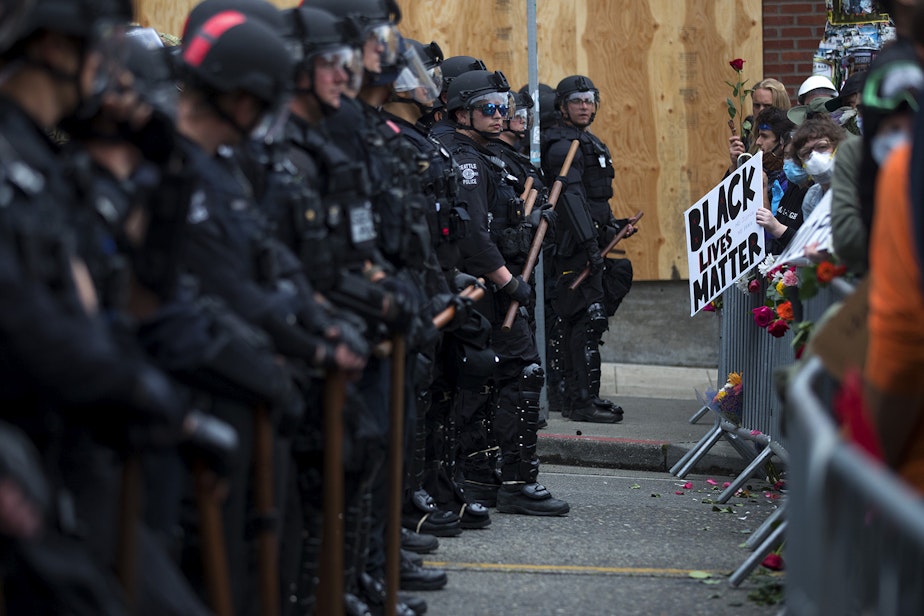Seattle police officers used excessive force in punching and pushing protesters, accountability office finds

The Seattle Office of Police Accountability has found that two officers, who arrested protesters separately in May and June, each used excessive force when doing so.
The findings, released on Friday, include those from a case in which an officer punched a man several times in the torso amid an arrest, and another in which an officer pushed a demonstrator to the ground twice, causing injuries to their head and face.
The Office of Police Accountability is a city-run agency that operates independent of the police department. Its newly released findings, detailed below, involve the following cases:
An officer causes a demonstrator's head to slam into the ground
An officer who arrested a demonstrator on June 7 and pushed them to the ground twice in the process, causing their head to hit the ground. The person was left with bruising to their temple and an abrasion to their chin, according to the investigation report for the case.
The Office of Police Accountability determined that the officer, who asserted he was almost twice the demonstrator’s size in his use of force report, used force that “was not proportional under the circumstances of this case.”
The findings further assert: “While it may not have been [the arresting officer’s] intent to cause the Complainant’s head and face to strike the ground, it was a foreseeable consequence of pushing them down twice given the positioning of the Complainant’s body and the relatively high level of force used for the pushes.”
RELATED: Child pepper spray case: Seattle Police accountability office finds no wrongdoing
Sponsored
The Office of Police Accountability reviewed both body-worn camera footage and a video of the arrest submitted by a civilian witness. Director Andrew Myerberg said the latter footage led to the deterimination that the officer had used more force than necessary in making the arrest.
"We slowed it down to four frames per second and then to 30 frames per second, to kind of really see what what's happening," Myerberg told KUOW. "And ... it appears that the officer is trying to pull the the individual's arm behind their back. And when doing so, with the other hand, the officer pushes the individual down to the ground, causing their head to strike the ground."
Two officers repeatedly punch a protester
Two officers each punched a demonstrator multiple times on May 29 — the first night of ongoing civil rights protests in Seattle this year — during the course of an arrest.
Sponsored
The man appeared to try and take one of the officer’s batons, the Office of Police Accountability wrote in its investigation report. Two officers attempted to arrest him and he resisted. Both officers reported that the man had struck them in the head with a water bottle during the arrest. However, investigators were only able to conclusively determine that one of the officers was hit, Myerberg said.
That officer responded by punching the man twice with a closed fist. Moments later, the second arresting officer punched the demonstrator in the torso “between six and eight times.”
Investigators determined, based on the timing of his punches, that the first officer had responded with appropriate force, considering his punches were "an immediate reaction to him being struck by the water bottle," and he stopped once it became clear the man was no longer going to hit him. That officer punched the man twice within the span of two seconds, the report states.
However, the investigation concluded that the second officer, who began punching the demonstrator 2.5 seconds after he swung the water bottle, had used excessive force. That officer threw multiple punches for a total of six seconds.
"[Police officers] have a duty under policy to modulate their force," Myerberg said. "And I think my concern is that the officer just simply didn't modulate his force."
Sponsored
Any disciplinary decisions in these cases will ultimately be made at the discretion of the Seattle police chief.
Additional cases
The Office of Police Accountability also investigated the following cases, none of which yielded any findings of misconduct:
"We were able to identify an officer who we believe was assigned or employed by Washington State Patrol who may have pointed a rifle that shoots ... rubber bullets in the vicinity of the complainant in the case," Myerberg said. "But we saw no evidence of an SPD employee who did that."
Additionally, Myerberg said his team "saw no indication that there was any kind of rude or contemptuous or derogatory statements that were made. It simply was asking her repeatedly, at times, politely, to move out of the way and her refusing."
Sponsored
- A woman accused Seattle police officers biased policing, falsely arresting her, improperly transporting her from a police precinct, and failing to read her Miranda rights to her.
- Two complainaints accused Seattle police officers of improperly directing a vehicle to ride behind demonstrators and using excessive force in pushing one of the complainaints to the ground.
Myerberg said his office currently has approximately 120 cases related to ongoing protests left to investigate.
"I think we've gotten through the initial crush of the cases," he said. "Because the protests themselves have slowed down a little bit, we've seen a significant slowdown in the cases we're getting. But we still get them sporadically."
Myerberg added that he and his team are bracing for more protest-related cases to potentially come following the outcome of the presidential election on November 3.

